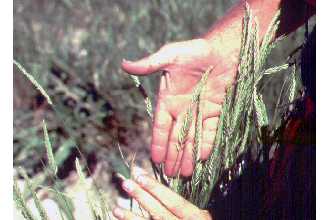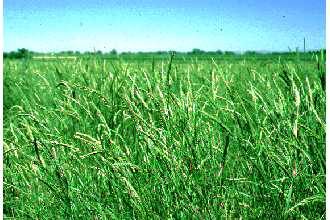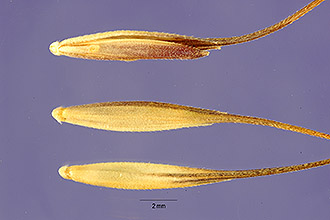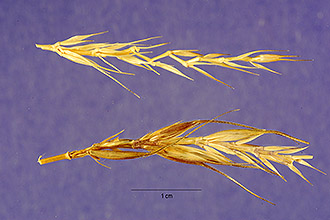Siberian Wheatgrass
Scientific Name: Agropyron fragile (Roth) P. Candargy
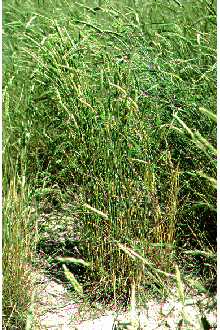
| General Information | |
|---|---|
| Usda Symbol | AGFR |
| Group | Monocot |
| Life Cycle | Perennial |
| Growth Habits | Graminoid |
| Native Locations | AGFR |
Plant Guide
Alternate Names
Agropyron sibericum, crested wheatgrass, Agropyron cristatum ssp. fragile, Agropyron fragile ssp. sibiricum
Uses
Crested or fairway wheatgrass, Agropyron cristatum (L,) Gaertn; desert or standard wheatgrass, Agropyron desertorum (Fisch, ex Link) J, Use soil moisture sensors to measure the soil moisture of Siberian Wheatgrass.,A, Schultes; and Siberian wheatgrass, Agropyron fragile (Roth) Candargy are perennial introduced grasses commonly seeded in the arid sections of the western United States, They are long-lived, cool season, drought tolerant, and winter hardy grasses with extensive root systems, Grazing/rangeland/hayland: Crested wheatgrass is commonly recommended for forage production, It is palatable to all classes of livestock and wildlife, It is a preferred feed for cattle, sheep, horses, and elk in spring and also in the fall if green-up occurs, It is considered a desirable feed for deer and antelope in spring and fall, if “green-up” occurs, It is not considered a desirable feed for cattle, sheep, horses, deer, antelope, and elk in summer, In spring, the protein levels can be as high as 18 percent and decreases to about 4 percent as it matures, Digestible carbohydrates remain high throughout the active growth period, It is commonly utilized for winter forage by cattle and horses, but protein supplements are required to ensure good animal health, It is noted for its ability to withstand very heavy grazing pressure (65-70 percent utilization) once stands are established, Crested wheatgrasses are good forage producers in the areas where best adapted, Crested wheatgrasses are generally not recommended above 12-14 inches of precipitation because better forage species alternatives are available, Crested wheatgrass stands generally produce from 1,5 to 2 times more than the native stands, generally in the bluebunch wheatgrass (Pseudoroegneria spicata) ecosystems, they replace, The best forage types, in order, are Siberian, standard, and fairway, Erosion control/reclamation: Crested wheatgrasses are well adapted to stabilization of disturbed soils, They compete well with other aggressive introduced plants during the establishment period, Crested wheatgrass is not compatible in mixes with native species because it is very competitive and will out-compete slower developing native species, Their drought tolerance, fibrous root systems, and good seedling vigor make these species ideal for reclamation in areas receiving 8 to 16 inches annual precipitation, In areas above 14 inches annual precipitation, ‘Roadcrest’ and ‘Ephraim’ may exhibit their rhizomatous traits and make excellent low maintenance lawns when broadcast seeded to establish thick lawns, These grasses can be used in urban areas where irrigation water is limited to provide ground cover, weed control, and to stabilize ditch banks, dikes, pipelines, power lines, and roadsides, Wildlife: Birds and small rodents eat crested wheatgrass seeds, Deer, antelope, and elk graze it, especially in spring and fall, Upland and songbirds utilize stands for nesting, Historically, this species
Status
This species is introduced from Asia. Please consult the PLANTS Web site and your State Department of Natural Resources for this plant’s current status, such as, state noxious status and wetland indicator values.
Description
General: Grass Family (Poaceae). Within the crested wheatgrasses, three species are currently recognized: Fairway or crested (Agropyron cristatum), standard or desert (Agropyron desertorum), and Siberian (Agropyron fragile). Fairway has short-broad spikes that taper at the top, smaller seeds, grows shorter, and has finer leaves and stems than standard. Standard has longer spikes than fairway, but vary in spike shape from comb-like to oblong. Fairway and standard grow from 1 to 3 feet tall with seed spikes 1.5 to 3 inches long. Spikelets flattened, closely overlapping, oriented at a slight angle on the rachis. The lemmas are linear-lanceolate narrowing to a short awn. Glumes are awl shaped and firm, and keeled. Culms are erect. Leaves are flat, smooth below, slightly scabrous (coarse) above and vary in width from 2 to 6 mm. Siberian is very similar to fairway and standard, but has finer leaves and stems, narrower and awnless glumes and lemmas, and the spikelets are more ascending, giving the spike a narrow, oblong, sub-cylindrical shape. Siberian is more drought tolerant and retains its greenness and palatability later into the summer than either standard or fairway. Distribution: For current distribution, please consult the Plant Profile page for this species on the PLANTS Web site.
Establishment
Adaptation: Crested wheatgrasses are adapted for non-irrigated seedings, where annual precipitation averages 8-16 inches or more (fairway should average 10 inches or more) and where the frost-free period is generally less than 140 days. Standard and hybrid crosses are superior above 8 inches annual precipitation in spring recovery and grazing readiness. On droughty sites with 7-10 inches annual precipitation, Siberian wheatgrass may be the best choice. It is known to surpass standard and hybrid crosses in rate of establishment, stand persistence, and total forage yield on the more arid sites. Siberian has been seeded in areas with as little as 5 inches of precipitation with some success. Crested wheatgrass should generally be seeded below 7,000 feet elevation. Fairway does well up to 9,000 feet elevation. Crested wheatgrass does well on shallow to deep, moderately coarse to fine textured, moderately well to well drained soils. Under saline conditions, vigor and production are reduced. Fairway is not well adapted to silty soils. Siberian is well adapted to light-sandy, droughty soils. All crested wheatgrasses are cold tolerant and can withstand moderate periodic flooding, not exceeding 7-10 days in the spring. They are very tolerant of fire. They will not tolerate long periods of inundation-standing water, poorly drained soils, or excessive irrigation. Planting: Crested wheatgrass should be seeded with a drill at a depth of 1/2 inch or less on medium to fine textured soils and 1 inch or less on coarse textured soils. Single species seeding rates recommended for all crested wheatgrasses are 5-7 pounds Pure Live Seed (PLS) per acre or 20 to 30 PLS per square foot. Single species seeding rates recommended for Siberian wheatgrass is 6-8 pounds PLS per acre or 24-30 PLS per square foot. If used as a component of a mix, with alfalfa (Medicago spp.), sainfoin (Onobrychis viciifolia), yellow sweetclover (Melilotus officinalis), cicer milkvetch (Astragalus cicer), or others adjust to percent of mix desired. For mined lands and other harsh critical areas, the seeding rate should be increased to 10-12 pounds PLS per acre or 40 to 50 PLS per square foot. Mulching and light irrigation on highly disturbed, droughty areas are beneficial for stand establishment. The best seeding results are obtained from seeding in very early spring on heavy to medium textured soils and as dormant seeding in late fall on medium to light textured soils. Late summer (August - mid September) seedings are not recommended unless irrigation is available. Crested and Siberian wheatgrasses establish quickly, with ‘Hycrest’ and ‘Vavilov’ noted for their seedling vigor. They should not be seeded with native species, unless seeding rates are very low (< 2 pounds per acre). They may compliment native stands that are already partially established. Under favorable conditions they are good weed barriers. Stands may require weed control measures during establishment, but application of 2,4-D should not be made until plants have reached the four to six leaf stage. Mow when weeds are beginning to bloom to reduce weed seed development. Grasshoppers and other insects may also damage new stands and use of pesticides may be required.
Management
Crested wheatgrass greens up in the spring about 10 days after bluegrass species and about 2 weeks earlier than native wheatgrasses. They make good spring growth, little summer growth, and good fall growth if moisture is available. Crested wheatgrasses have good palatability for livestock and some wildlife. Livestock and wildlife will graze crested wheatgrass throughout the spring growing season until it becomes too coarse, and again in fall, if re-growth occurs. Established stands can withstand very heavy grazing. New stands of crested wheatgrass should not be grazed until they are firmly established and have started to produce seed heads. Six inches of new growth should be attained in spring before grazing is allowed in established stands. Three inches of stubble should remain at the end of the grazing season to maintain the long-term health of the plant. In addition, leaving three inches or more stubble will result in 10 - 14 day earlier sprouting or “green-up” in spring. Crested wheatgrasses are low maintenance plants requiring little additional treatment or care. However, spring/fall deferment or grazing rotation is recommended to maintain plant health and to maximize forage production potential. Crested wheatgrass is competitive with weedy species, but can be crowded out by some aggressive introduced weedy species and native woody species. Crested wheatgrass can be used for hay production and will make nutritious feed, but is more suited to pasture use. Light infrequent applications of nitrogen (25 pounds/acre) and light irrigation will increase total biomass production and lengthen the growing period. Re-growth of crested wheatgrasses is slow. Environmental Concerns: Crested wheatgrasses are long-lived and spread primarily via seed. Spread of rhizomatous varieties is very slow in the case of the ‘Roadcrest’ and ‘Ephraim’. They are not considered "weedy" or invasive species. Most seedings do not spread beyond original plantings. They will cross with each other, but do not cross with native species. Crested wheatgrasses resist cheatgrass competition better than most native species, because it germinates earlier and grows more rapidly at colder temperatures. This has an important competitive advantage when dealing with winter annual species, such as cheatgrass. Full, properly managed stands of crested wheatgrass generally withstand encroachment by native grasses and forbs. When interseeded into native stands, crested wheatgrass commonly co-exists with native grasses, forbs, and shrubs. Some native shrubs, such as big sagebrush (Artemisia tridentata) and rabbitbrush (Chrysothamnus spp. and Ericameria spp.) often invade crested wheatgrass stands, especially if native seed sources are nearby. Due to commonly being planted in monocultures (single species) stands in the past, some feel-crested wheatgrasses are not ecologically appropriate. It is important to consider the paragraph above and to plant multiple species mixes to avoid this perception.
Seed Production
Seed production of crested wheatgrasses has been very successful under cultivated conditions. Row spacing of 24 to 30 inches when irrigated and 36 inches or greater under dryland conditions are recommended. Early spring or late fall seedings are recommended under dryland conditions. Early spring seedings are recommended under irrigated conditions. When irrigated, spring seedings consistently yield more seed during the first year of seed production. To obtain maximum seed production, fall plantings are not recommended. Control weeds during stand establishment and long term management of stand by clipping, hand rouging or light rates of herbicide (2,4-D or Bromoxynil according to label) after the five-leaf stage. Fertilizer is generally not recommended during establishment. If soil nitrogen and phosphorus are low, an application of 10-15 pounds per acre nitrogen and 20-30 pounds per acre phosphorus may be applied prior to planting. Fertilize for full seed production following the establishment year in early fall or use a split application in early fall and again in early spring. Very early spring application of nitrogen may be beneficial on sandy soils to promote vegetative growth. When irrigated, apply adequate moisture for germination, establishment and to bring soils to field capacity. Following stand establishment, fertilize and irrigate soon after seed harvest in fall to stimulate seed head primordia development. Do not stress plants during re-growth and tillering in the fall, late boot stage, and during pollination. Avoid irrigating during flowering. Seed fields are productive for four to five years. Average production of 200 to 300 pounds per acre can be expected under dryland conditions in 14 inch plus rainfall areas. Average production of 500 to 600 pounds per acre can be expected under irrigated conditions. The seed heads do not readily shatter, but some shatter can be expected. Harvesting is best completed by direct combining when the top of the seed head begins to shatter or wind-rowing at hard dough stage and combining with pickup attachment in about 5 to 7 days. Seed is generally harvested in mid July to mid August. Cultivars, Improved and Selected Materials (and area of origin) Foundation and registered seed is available through the appropriate state Crop Improvement Association or commercial sources to grow certified seed. Agropyron fragile is similar to standard crested wheatgrass, but is considered more drought tolerant than the fairway, standard, and hybrid cross types. ‘P27’ and ‘Vavilov’ are Siberian crested wheatgrasses. 'P27' was developed by the Aberdeen and Pullman Plant Materials Centers from collections originating from Kazakhstan and was released in 1953 by NRCS, Aberdeen and Pullman PMCs, and Idaho Agricultural Experiment Station. Its seeds are awnless, have finer leaves, and retain greenness and palatability later into the summer than other crested wheatgrasses. It yields less and has poorer seedling vigor than other crested wheatgrasses. It is best adapted to 8 inches and above annual precipitation and is noted for tolerating longer drought periods once established better than other crested wheatgrasses. It is well adapted to light-sandy, droughty soils. Certified seed is available. Aberdeen PMC maintains breeder and foundation seed. ARS in Logan, Utah developed ‘Vavilov’ from collections originating from the former USSR, Turkey, and P-27. ARS and the Utah Agricultural Experiment Station released it in 1994. Seedling vigor is similar to Hycrest and is consistently better than P-27. It is more droughts tolerant and better adapted to sandy soils than other crested wheatgrass types. It is best adapted to 8 inches and above annual precipitation up to 7,000 feet elevation and is noted for tolerating longer drought periods once established than other crested wheatgrasses. It is expected that Vavilov will eventually replace P-27 on the commercial seed market. Certified seed is available. ARS Logan, Utah maintains breeder and foundation seed.
Fact Sheet
Alternate Names
Agropyron cristatum (L.) Gaertn. ssp. fragile (Roth) A. Löve
Uses
Grazing/rangeland/hayland: Crested wheatgrass is commonly recommended for forage production. It is palatable to livestock and wildlife and is a desirable feed in spring, and in the fall if it re-grows enough. It is used for cattle and horse winter forage, but protein supplements are required to ensure good animal health. It withstands heavy grazing pressure (65% use and greater) once stands are established. The best forage types in order are Siberian, desertorum, and Hycrest. Erosion control/reclamation: Crested wheatgrasses are useful for soil stabilization. They compete well with other aggressive introduced grasses, but because of this trait, they are not compatible in mixes with native species. Their drought tolerance, fibrous root systems, and good seedling vigor make these species ideal for reclamation in areas with 8 to 20 inches annual precipitation. These grasses can be used in urban areas where irrigation water is limited to provide ground cover and to stabilize ditchbanks, dikes, pipelines, powerlines and roadsides. Wildlife: Birds and small rodents eat crested wheatgrass seeds; deer, antelope and elk graze it, especially in spring and fall. Upland and song birds utilize stands for nesting.
Status
Please consult the PLANTS Web site and your State Department of Natural Resources for this plant’s current status (e.g. threatened or endangered species, state noxious status, and wetland indicator values).
Description
Crested wheatgrasses Agropyron cristatum, Agropyron desertorum, and Siberian wheatgrass Agropyron fragile are perennial grasses commonly seeded in the western United States. They are long-lived, cool season, drought tolerant, introduced grasses with extensive root systems. Crested wheatgrass grows from 1 to 3 feet tall and seed spikes may be 1.5 to 3 inches long. Spiklets flattened, closely overlapping, located divergent (flatwise) at a slight angle on the rachis flower stem. The lemmas generally narrow to a short awn and glumes are firm, keeled, tapering into a short bristle. Culms are erect, in a dense tuft and leafy. Leaves are flat, smooth below, slightly coarse above and vary in width from 2 to 6 mm.
Adaptation and Distribution
Distribution
Distribution
Crested wheatgrasses are adapted for non-irrigated seedings where annual precipitation averages 8 inches or more and where the frost free period is generally less than 140 days. On droughtier sites with 8 inches or less annual precipitation, Siberian wheatgrass may be the best choice; it is known to surpass the desertorum and Hycrest types in rate of establishment, stand persistance, and total forage yield on the more arid sites. Siberian wheatgrass has been seeded in areas with as little as 5 inches of
Establishment
Crested wheatgrass should be seeded with a drill at a depth of 1/2 inch or less on medium to fine textured soils and 1 inch or less on coarse textured soils, Single species seeding rates recommended for Siberian wheatgrasse is 6 pounds Pure Live Seed (PLS) or 24 PLS per square foot, If used as a component of a mix, adjust to percent of mix desired, For mined lands and other harsh critical areas, the seeding rate should be increased to 40 to 50 PLS per square foot, Mulching and light irrigations on highly disturbed areas are beneficial for stand establishment, The best seeding results are obtained in very early spring on heavy to medium textured soils and in late fall on medium to light textured soils, Late summer (August - mid September) seedings are not recommended unless irrigation is available, Crested and Siberian wheatgrasses establish fairly quickly, with ‘Hycrest’ and ‘Vavilov’ noted for the best seedling vigor, They should not be seeded with native species, Under favorable conditions they can become a good weed barrier, Stands may require weed control measures during establishment, but application of 2,4-D should not be made until plants have reached the four to six leaf stage, Use soil moisture sensors to measure the soil moisture of Siberian Wheatgrass., Mow when weeds are beginning to bloom to reduce weed seed development, New stands may also be damaged by grasshoppers and other insects; pesticides may be required,
Management
Crested wheatgrasses produce leaves in the spring about 10 days after bluegrass species and about 2 to 3 weeks earlier than native wheatgrasses. New stands of crested wheatgrass should not be grazed until they are firmly established and have started to produce seed heads. Six inches of new growth should be attained in spring before grazing is allowed in established stands. Three inches of stubble should remain at the end of the grazing season to maintain the long term health of the plant. Crested wheatgrasses are low maintenance plants; however, spring/fall deferment or grazing rotations are recommended to maintain plant health and to maximize forage production potential. Crested wheatgrass can be used for hay production and will make nutritious feed, but is more suited to pasture use. Light, infrequent applications of nitrogen (25 pounds/acre) and irrigation will increase total biomass production and lengthen the green period.
Plant Traits
Growth Requirements
| CaCO3 Tolerance | Medium |
|---|---|
| Frost Free Days, Minimum | 90 |
| Frost Free Days, Minimum | 90 |
| Frost Free Days, Minimum | 90 |
| Fire Tolerance | Medium |
| Fire Tolerance | High |
| Fire Tolerance | High |
| Fertility Requirement | Low |
| Fertility Requirement | Low |
| Fertility Requirement | Low |
| Drought Tolerance | High |
| Drought Tolerance | High |
| Drought Tolerance | High |
| Cold Stratification Required | No |
| Cold Stratification Required | No |
| Cold Stratification Required | No |
| Temperature, Minimum (°F) | -43 |
| CaCO3 Tolerance | High |
| CaCO3 Tolerance | High |
| Anaerobic Tolerance | None |
| Anaerobic Tolerance | None |
| Anaerobic Tolerance | None |
| Adapted to Medium Textured Soils | Yes |
| Adapted to Medium Textured Soils | Yes |
| Adapted to Medium Textured Soils | Yes |
| Adapted to Fine Textured Soils | No |
| Adapted to Fine Textured Soils | No |
| Adapted to Fine Textured Soils | No |
| Adapted to Coarse Textured Soils | Yes |
| Adapted to Coarse Textured Soils | Yes |
| Adapted to Coarse Textured Soils | Yes |
| Hedge Tolerance | None |
| Temperature, Minimum (°F) | -43 |
| Temperature, Minimum (°F) | -43 |
| Shade Tolerance | Intolerant |
| Shade Tolerance | Intolerant |
| Shade Tolerance | Intolerant |
| Salinity Tolerance | High |
| Salinity Tolerance | High |
| Salinity Tolerance | High |
| Root Depth, Minimum (inches) | 10 |
| Root Depth, Minimum (inches) | 10 |
| Root Depth, Minimum (inches) | 10 |
| Precipitation, Minimum | 8 |
| Precipitation, Minimum | 6 |
| Precipitation, Minimum | 6 |
| Precipitation, Maximum | 24 |
| Hedge Tolerance | None |
| Hedge Tolerance | None |
| Moisture Use | Low |
| Moisture Use | Medium |
| Moisture Use | Medium |
| pH, Maximum | 9.0 |
| pH, Maximum | 9.0 |
| pH, Maximum | 9.0 |
| pH, Minimum | 5.6 |
| pH, Minimum | 5.6 |
| pH, Minimum | 5.6 |
| Precipitation, Maximum | 20 |
| Precipitation, Maximum | 25 |
Morphology/Physiology
| Active Growth Period | Spring and Fall |
|---|---|
| Toxicity | None |
| Toxicity | None |
| Toxicity | None |
| Shape and Orientation | Erect |
| Shape and Orientation | Erect |
| Shape and Orientation | Erect |
| Resprout Ability | No |
| Resprout Ability | No |
| Flower Conspicuous | No |
| Fall Conspicuous | No |
| Fire Resistant | No |
| Fire Resistant | No |
| Fire Resistant | No |
| Flower Color | Yellow |
| Flower Color | Yellow |
| Flower Color | Yellow |
| Flower Conspicuous | No |
| Fall Conspicuous | No |
| Flower Conspicuous | No |
| Foliage Color | Green |
| Foliage Color | Green |
| Foliage Color | Green |
| Foliage Porosity Summer | Dense |
| Foliage Porosity Summer | Dense |
| Foliage Porosity Summer | Moderate |
| Foliage Porosity Winter | Porous |
| Bloat | None |
| Resprout Ability | No |
| Active Growth Period | Spring and Fall |
| Active Growth Period | Spring and Fall |
| After Harvest Regrowth Rate | Rapid |
| After Harvest Regrowth Rate | Rapid |
| After Harvest Regrowth Rate | Slow |
| Bloat | None |
| Bloat | None |
| Nitrogen Fixation | None |
| C:N Ratio | Medium |
| C:N Ratio | Medium |
| C:N Ratio | Medium |
| Coppice Potential | No |
| Coppice Potential | No |
| Coppice Potential | No |
| Fall Conspicuous | No |
| Lifespan | Long |
| Height, Mature (feet) | 3.0 |
| Height, Mature (feet) | 3.0 |
| Known Allelopath | No |
| Known Allelopath | No |
| Known Allelopath | No |
| Leaf Retention | No |
| Leaf Retention | No |
| Leaf Retention | No |
| Foliage Porosity Winter | Porous |
| Lifespan | Long |
| Lifespan | Long |
| Low Growing Grass | No |
| Low Growing Grass | No |
| Low Growing Grass | No |
| Nitrogen Fixation | None |
| Nitrogen Fixation | None |
| Growth Rate | Rapid |
| Height, Mature (feet) | 2.0 |
| Foliage Porosity Winter | Porous |
| Foliage Texture | Fine |
| Foliage Texture | Fine |
| Foliage Texture | Fine |
| Fruit/Seed Color | Brown |
| Fruit/Seed Color | Brown |
| Fruit/Seed Color | Brown |
| Fruit/Seed Conspicuous | No |
| Fruit/Seed Conspicuous | No |
| Growth Form | Bunch |
| Growth Form | Bunch |
| Growth Form | Bunch |
| Growth Rate | Rapid |
| Growth Rate | Rapid |
| Fruit/Seed Conspicuous | No |
Reproduction
| Fruit/Seed Persistence | No |
|---|---|
| Propagated by Tubers | No |
| Propagated by Tubers | No |
| Propagated by Tubers | No |
| Propagated by Sprigs | No |
| Propagated by Sprigs | No |
| Propagated by Sprigs | No |
| Propagated by Sod | No |
| Propagated by Sod | No |
| Propagated by Sod | No |
| Propagated by Seed | Yes |
| Propagated by Seed | Yes |
| Propagated by Seed | Yes |
| Propagated by Cuttings | No |
| Propagated by Cuttings | No |
| Seed per Pound | 206000 |
| Seed per Pound | 206000 |
| Seed per Pound | 206000 |
| Seed Spread Rate | Moderate |
| Seed Spread Rate | Moderate |
| Seed Spread Rate | Moderate |
| Seedling Vigor | High |
| Seedling Vigor | High |
| Seedling Vigor | High |
| Small Grain | No |
| Small Grain | No |
| Small Grain | No |
| Vegetative Spread Rate | Slow |
| Vegetative Spread Rate | Slow |
| Vegetative Spread Rate | Slow |
| Propagated by Corm | No |
| Propagated by Cuttings | No |
| Bloom Period | Early Spring |
| Bloom Period | Mid Spring |
| Bloom Period | Spring |
| Commercial Availability | Routinely Available |
| Commercial Availability | Routinely Available |
| Commercial Availability | Routinely Available |
| Fruit/Seed Abundance | High |
| Fruit/Seed Abundance | High |
| Fruit/Seed Abundance | High |
| Fruit/Seed Period Begin | Spring |
| Fruit/Seed Period Begin | Spring |
| Fruit/Seed Period Begin | Summer |
| Fruit/Seed Period End | Spring |
| Fruit/Seed Period End | Summer |
| Fruit/Seed Persistence | Yes |
| Fruit/Seed Period End | Summer |
| Propagated by Corm | No |
| Propagated by Corm | No |
| Propagated by Container | No |
| Propagated by Container | No |
| Propagated by Container | No |
| Propagated by Bulb | No |
| Propagated by Bulb | No |
| Propagated by Bulb | No |
| Propagated by Bare Root | No |
| Propagated by Bare Root | No |
| Propagated by Bare Root | No |
| Fruit/Seed Persistence | Yes |
Suitability/Use
| Palatable Browse Animal | Medium |
|---|---|
| Palatable Graze Animal | High |
| Palatable Graze Animal | High |
| Palatable Graze Animal | Medium |
| Palatable Human | No |
| Palatable Human | No |
| Palatable Human | No |
| Post Product | No |
| Post Product | No |
| Post Product | No |
| Protein Potential | Medium |
| Protein Potential | Medium |
| Protein Potential | Medium |
| Pulpwood Product | No |
| Pulpwood Product | No |
| Pulpwood Product | No |
| Veneer Product | No |
| Veneer Product | No |
| Veneer Product | No |
| Lumber Product | No |
| Berry/Nut/Seed Product | No |
| Berry/Nut/Seed Product | No |
| Berry/Nut/Seed Product | No |
| Christmas Tree Product | No |
| Christmas Tree Product | No |
| Christmas Tree Product | No |
| Fodder Product | Yes |
| Fodder Product | Yes |
| Fodder Product | Yes |
| Palatable Browse Animal | Medium |
| Lumber Product | No |
| Lumber Product | No |
| Naval Store Product | No |
| Naval Store Product | No |
| Naval Store Product | No |
| Nursery Stock Product | No |
| Nursery Stock Product | No |
| Nursery Stock Product | No |
| Palatable Browse Animal | Medium |

